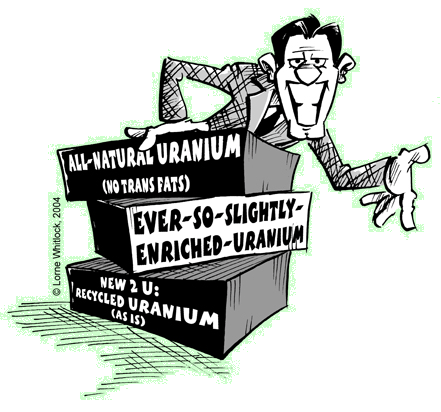Published in the December 2004
issue of the Canadian
Nuclear Society Bulletin, Vol.25, No.4. Artwork
by Lorne Whitlock.
Slightly Semantic by Jeremy Whitlock This industry has had an image problem since they first coined the phrase "going critical" for a self-sustained fission chain reaction. Simply put, we're scientists and engineers, and not PR specialists. To this day there are still very few PR specialists in the industry, and, sadly, getting fewer all the time. "Going critical" is what a reactor does, and frankly that's a much better phrase than "self-sustained chain reaction". Try to tell your friends that your reactor will soon be going critical, however, and watch how the conversation turns. Effuse about Qinshan going critical ahead of schedule and you'll soon learn who has been harbouring conspiracy theories about the nuclear industry all along. Our capacity to frighten knows no bounds: We speak with confidence of the "Most Exposed Individual", a mysterious unfortunate living amongst the public. We laud a reactor's "containment", clearly a serious measure invoked when accidents equal disasters, last seen failing miserably in the likes of Jurassic Park and Ghostbusters. We seek solutions for our nuclear "waste", apparently more dangerous than anything else on earth judging by our unprecedented approach - notwithstanding, of course, the fact that we currently store the material in "swimming pools". The public requires "defense in depth", in lieu of protection from the need to defend. We design mighty coolant tubes that "leak", with the consolation that this happens before they "break". We have legislation that limits our "liability" to the public (rather than our indemnification) in case of an accident. The list goes on, but the point is that we did not invent our terminology with a view to public perception. Nowhere is this more acutely evident than in Port Hope, Ontario, where for over a year the uranium giant Cameco Corporation has been nurturing public understanding of "Slightly Enriched Uranium", or SEU. The backdrop is the company's quest for a license to down-blend foreign LEU ("Low Enriched", or LWR-grade, uranium) into SEU, soon to be a fuel of choice in the CANDU market. Now, a sillier term than "slightly enriched uranium" is hard to imagine but of course it makes perfect sense from the technical point of view. Here is a fuel somewhere between natural and traditional "low" enrichment (lower than low, if you will).
To the suspicious eye, however, somewhat accustomed to the wiles of natural uranium (it may be evil, but it's a natural evil), any kind of "enriched" uranium is a step in the wrong direction. We note the irony in "depleted" uranium being a step in the wrong direction as well, but that's another story. So, rather than admit its complicity in a global conspiracy to blow everything up, it is natural that Big Uranium would attempt to pass off its new product as "slightly" enriched. Tobacco, of course, is slightly addictive, and SUVs slightly polluting. Factor in the risk of enriched uranium "going slightly critical", and you get a sense of the PR challenge facing Cameco. After a slightly pregnant pause to reflect, one imagines slightly more market-friendly product labelling. It is possible, after all, to be technically complex and publicly tolerable at the same time. Witness the microwave: "micro" because small is good, and "wave" because only things that come in particles are dangerous. Put the two together and you've got a socially acceptable technology capable of beaming porn into every home on the planet. Consider the "laser": a friendlier product with a more ambiguous name you'd be hard-pressed to find. Perhaps, then, the concerned citizens of Port Hope may have found "down-graded LEU" easier to accept than "slightly enriched". Or what about "LEU-Lite"? Or, getting right to the point, how about "high-efficiency uranium"? A personal favourite is "Uranium Jazz", with apologies to Air Canada. Throw in an endorsement contract with CÚline Dion, and the Environmental Assessment would have been in the bag.
| ||||
|
Discussion welcome.
©2011 Jeremy Whitlock
| ||||
|
|

